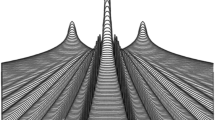Abstract
A model of reality is called separable if the state of a composite system is equal to the union of the states of its parts, located in different regions of space. Spekkens has argued that it is trivial to reproduce the predictions of quantum mechanics using a separable ontological model, provided one allows for arbitrary violations of ‘dynamical locality’. However, since dynamical locality is strictly weaker than local causality, this leaves open the question of whether an ontological model for quantum mechanics can be both separable and dynamically local. We answer this question in the affirmative, using an ontological model based on previous work by Deutsch and Hayden. Although the original formulation of the model avoids Bell’s theorem by denying that measurements result in single, definite outcomes, we show that the model can alternatively be cast in the framework of ontological models, where Bell’s theorem does apply. We find that the resulting model violates local causality, but satisfies both separability and dynamical locality, making it a candidate for the ‘most local’ ontological model of quantum mechanics.


Similar content being viewed by others
Notes
To be precise, the authors show that one can keep ‘relativistic causality’ and ‘common causes’ at the expense of ‘decorrelating explanation’. The first two can be shown to imply dynamical locality and we interpret the latter as equivalent to factorisation.
Specifically, we assume that the causes of the experimenter’s choice are not relevant to the variables under investigation. Our assumption is equivalent to ‘free choice’ as described in Ref. [3].
References
Deutsch, D.: Vindication of quantum locality. Proc. R. Soc. Lond. A 468(2138), 531–544 (2011)
Bell, J.S.: The theory of local Beables. Epistemol. Lett. 9, 85 (1976)
Wiseman, H., Cavalcanti, E.: Causarum investigatio and the two bell’s theorems of john bell. arXiv:1503.06413 (2015)
Harrigan, N., Spekkens, R.W.: Einstein, incompleteness, and the epistemic view ofquantum states. Found. Phys. 40(2), 125–157 (2010)
Spekkens, R.W.: Contextuality for preparations, transformations, and unsharp measurements. Phys. Rev. A 71, 052108 (2005)
Bohm, D.: A suggested interpretation of the quantum theory in terms of ‘hidden’ variables. I. Phys. Rev. 85, 166–179 (1952)
Howard, D.: Einstein on locality and separability. Stud. Hist. Philos. Sci. A 16(3), 171–201 (1985)
Henson, J.: Non-separability does not relieve the problem of Bell’s theorem. Found. Phys. 43(8), 1008–1038 (2013)
Spekkens, R.-W.: The paradigm of kinematics and dynamics must yield to causal structure. In: Aguirre, A., Foster, B., Merali, Z. (eds.) Questioning the foundations of physics, the frontiers collection, pp. 5–16. Springer, New York (2015)
Deutsch, D., Hayden, P.: Information flow in entangled quantum systems. Proc. R. Soc. Lond. A 456(1999), 1759–1774 (2000)
Gottesman, D.: The Heisenberg Representation of Quantum Computers, Ph.D. Thesis 1998
Timpson, C.G.: Nonlocality and information flow: the approach of deutsch and hayden. Found. Phys. 35(2), 313–343 (2005)
Wallace, D., Timpson, C.G.: Quantum mechanics on spacetime I: spacetime state realism. Br. J. Philos. Sci. 61(4), 697–727 (2010)
Hewitt-Horsman, C., Vedral, V.: Developing the Deutsch–Hayden approach to quantum mechanics. N. J. Phys. 9(5), 135 (2007)
Brown, H.R., Timpson, C.G.: Bell on bell’s theorem: the changing face of nonlocality. arXiv:1501.03521 (2014)
Cavalcanti, E.G., Lal, R.: On modifications of Reichenbach’s principle of common cause in light of Bell’s theorem. J. Phys. A 47(42), 424018 (2014)
Butterfield, J.: Bell’s theorem: what it takes. Br. J. Philos. Sci. 43(1), 41–83 (1992)
Leifer, M.: Is the quantum state real? an extended review of psi-ontology theorems. Quanta 3(1), 67–155 (2014)
Wallace, D., Timpson, C.G.: Non-locality and gauge freedom in Deutsch and Hayden’s formulation of quantum mechanics. Found. Phys. 37(6), 951–955 (2007)
Acknowledgments
This work has been supported by the European Commission Project RAQUEL, the John Templeton Foundation, FQXi, and the Austrian Science Fund (FWF) through CoQuS, SFB FoQuS, and the Individual Project 2462.
Author information
Authors and Affiliations
Corresponding author
Rights and permissions
About this article
Cite this article
Pienaar, J. A Separable, Dynamically Local Ontological Model of Quantum Mechanics. Found Phys 46, 104–119 (2016). https://doi.org/10.1007/s10701-015-9958-6
Received:
Accepted:
Published:
Issue Date:
DOI: https://doi.org/10.1007/s10701-015-9958-6




